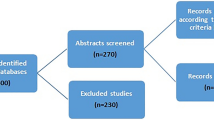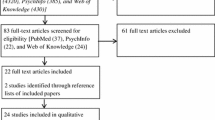Abstract
Purpose
To find associations between knowledge about risk factors for breast cancer and the socioeconomic status of healthy women, as well as their attitude toward taking chemopreventive drugs.
Patients and methods
Between April and September 1999, 7135 healthy women completed questionnaires providing information about their willingness to take chemopreventive drugs. Items in the questionnaire included the sources of the information they had, their estimates of the population and personal lifetime risk, and risk factors for breast cancer.
Results
A total of 6597 questionnaires were evaluable. The responders’ median age was 44. Fifty-five percent of the women were willing to consider receiving chemopreventive drugs to lower their risk for breast cancer. Participants who estimated the population risk as being very high were more disposed to receive chemoprevention (65.3%), as were women who estimated their own breast cancer risk as being high (74.1%). A family history of breast cancer only had a low impact on willingness to receive chemoprevention. Women with a family history of breast cancer were willing to take chemopreventive agents in 57.2% of cases. The multivariate analysis showed that knowing about risk factors and having a lower educational level were factors positively correlated with willingness to consider chemoprevention.
Conclusion
These findings emphasize the role of estimations of the risk of breast cancer for patients considering whether to accept chemoprevention treatment. To date, only a few modern models of risk estimation have been evaluated in relation to chemoprevention. There is a need for better integration of professional risk estimations into clinical practice.
Similar content being viewed by others
References
Cuzick J, Forbes J, Edwards R et al (2002) First results from the International Breast Cancer Intervention Study (IBIS-I): a randomised prevention trial. Lancet 360:817–824
Fisher B, Costantino JP, Wickerham DL et al (1998) Tamoxifen for prevention of breast cancer: report of the National Surgical Adjuvant Breast and Bowel Project P-1 Study. J Natl Cancer Inst 90:1371–1388
Powles T, Eeles R, Ashley S et al (1998) Interim analysis of the incidence of breast cancer in the Royal Marsden Hospital tamoxifen randomised chemoprevention trial. Lancet 352:98–101
Veronesi U, Maisonneuve P, Sacchini V et al (2002) Tamoxifen for breast cancer among hysterectomised women. Lancet 359:1122–1124
Cauley JA, Norton L, Lippman ME et al (2001) Continued breast cancer risk reduction in postmenopausal women treated with raloxifene: 4-year results from the MORE trial. Multiple outcomes of raloxifene evaluation. Breast Cancer Res Treat 65:125–134
Cuzick J, Powles T, Veronesi U et al (2003) Overview of the main outcomes in breast-cancer prevention trials. Lancet 361:296–300
Goss PE, Ingle JN, Martino S et al (2003) A randomized trial of letrozole in postmenopausal women after five years of tamoxifen therapy for early-stage breast cancer. N Engl J Med 349:1793–1802
ATAC Trialists (2002) Anastrozole alone or in combination with tamoxifen versus tamoxifen alone for adjuvant treatment of postmenopausal women with early breast cancer: first results of the ATAC randomised trial. Lancet 359:2131–2139
Thurlimann B, for the BIG 1-98 Collaborative Group X: BIG 1-98 (2005) A prospective randomized double-blind double-dummy phase III study to evaluate letrozole as adjuvant endocrine therapy for postmenopausal women with receptor-positive breast cancer. Breast 14(Suppl 1):S3
Coombes RC, Hall E, Gibson LJ et al (2004) A randomized trial of exemestane after two to three years of tamoxifen therapy in postmenopausal women with primary breast cancer. N Engl J Med 350:1081–1092
Jakesz R, Kaufmann M, Gnant M et al (2004) Benefits of switching postmenopausal women with hormone-sensitive early breast cancer to anastrozole after 2 years adjuvant tamoxifen: combined results from 3,123 women enrolled in the ABCSG Trial 8 and the ARNO 95 Trial. Breast Cancer Res Treat 88(Suppl 1):S7
Cuzick J (2005) Aromatase inhibitors for breast cancer prevention. J Clin Oncol 23:1636–1643
Siminoff LA, Zhang A, Colabianchi N et al (2000) Factors that predict the referral of breast cancer patients onto clinical trials by their surgeons and medical oncologists. J Clin Oncol 18:1203–1211
Lara PN Jr, Higdon R, Lim N et al (2001) Prospective evaluation of cancer clinical trial accrual patterns: identifying potential barriers to enrollment. J Clin Oncol 19:1728–1733
Paskett ED, Cooper MR, Stark N et al (2002) Clinical trial enrollment of rural patients with cancer. Cancer Pract 10:28–35
Murthy VH, Krumholz HM, Gross CP (2004) Participation in cancer clinical trials: race-, sex-, and age-based disparities. JAMA 291:2720–2726
Gross CP, Murthy V, Li Y et al (2004) Cancer trial enrollment after state-mandated reimbursement. J Natl Cancer Inst 96:1063–1069
Gross CP, Krumholz HM (2005) Impact of managed care on cancer trial enrollment. J Clin Oncol 23:3811–3818
Ellis PM, Butow PN, Simes RJ et al (1999) Barriers to participation in randomized clinical trials for early breast cancer among Australian cancer specialists. Aust NZ J Surg 69:486–491
Ellis PM, Butow PN, Tattersall MH et al (2001) Randomized clinical trials in oncology: understanding and attitudes predict willingness to participate. J Clin Oncol 19:3554–3561
Simon MS, Du W, Flaherty L et al (2004) Factors associated with breast cancer clinical trials participation and enrollment at a large academic medical center. J Clin Oncol 22:2046–2052
Gross CP, Filardo G, Mayne ST et al (2005) The impact of socioeconomic status and race on trial participation for older women with breast cancer. Cancer 103:483–491
Powles TJ (2002) Breast cancer prevention. Oncologist 7:60–64
von Minckwitz G, Prieshof B, Hofmann K et al (2002) Prevention with goserelin and ibandronate in premenopausal women with familial breast cancer risk: first experiences of the GISS study. Arch Gynecol Obstet 267(Suppl 1):S52
Vernon SW, Yeomans AC, Frankowski R et al (1995) Behavioral and social factors that predict participation in the Breast Cancer Prevention Trial. Ann NY Acad Sci 768:300
Yeomans-Kinney A, Vernon SW, Frankowski RF et al (1995) Factors related to enrollment in the breast cancer prevention trial at a comprehensive cancer center during the first year of recruitment. Cancer 76:46–56
Yeomans Kinney AY, Richards C, Vernon SW et al (1998) The effect of physician recommendation on enrollment in the Breast Cancer Chemoprevention Trial. Prev Med 27:713–719
Yeomans Kinney A, Vernon SW, Shui W et al (1998) Validation of a model predicting enrollment status in a chemoprevention trial for breast cancer. Cancer Epidemiol Biomarkers Prev 7:591–595
Wacholder S (2004) Bias in intervention studies that enroll patients from high-risk clinics. J Natl Cancer Inst 96:1204–1207
Paepke S, Schubert R, Huttner C et al (2000) Breast cancer awareness and screening behavior: a cross-sectional analysis of 2110 women. Geburtshilfe Frauenheilkd 60:620–624
Gail MH, Brinton LA, Byar DP et al (1989) Projecting individualized probabilities of developing breast cancer for white females who are being examined annually. J Natl Cancer Inst 81:1879–1886
Claus EB, Risch N, Thompson WD (1994) Autosomal dominant inheritance of early-onset breast cancer: implications for risk prediction. Cancer 73:643–651
Parmigiani G, Berry D, Aguilar O (1998) Determining carrier probabilities for breast cancer-susceptibility genes BRCA1 and BRCA2. Am J Hum Genet 62:145–158
Antoniou AC, Pharoah PP, Smith P et al (2004) The BOADICEA model of genetic susceptibility to breast and ovarian cancer. Br J Cancer 91:1580–1590
Tyrer J, Duffy SW, Cuzick J (2004) A breast cancer prediction model incorporating familial and personal risk factors. Stat Med 23:1111–1130
Amir E, Evans DG, Shenton A et al (2003) Evaluation of breast cancer risk assessment packages in the family history evaluation and screening programme. J Med Genet 40:807–814
Fasching PA, Nestle-Kraemling C, Bani M et al (2004) Breast cancer risk assessment in clinical use: prediction of BRCA mutation and estimation of lifetime risk by BRCAPRO, MENDEL and the Tyrer–Cuzick model. J Cancer Res Clin Oncol 130(Suppl):S57
Author information
Authors and Affiliations
Corresponding author
Rights and permissions
About this article
Cite this article
Fasching, P.A., von Minckwitz, G., Fischer, T. et al. The impact of breast cancer awareness and socioeconomic status on willingness to receive breast cancer prevention drugs. Breast Cancer Res Treat 101, 95–104 (2007). https://doi.org/10.1007/s10549-006-9272-2
Received:
Accepted:
Published:
Issue Date:
DOI: https://doi.org/10.1007/s10549-006-9272-2




